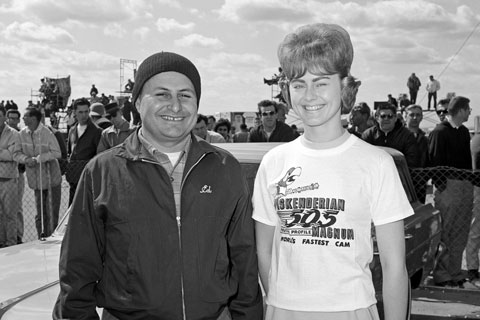SEMA News—January 2014
HERITAGE
By Drew Hardin
Photo Courtesy Petersen Archives
Putten der Growl in der Beetle
 At first glance, it would seem that hot-rodding magazines in the ‘60s were all about high-horsepower, big-cubic-inch stuff—drag racing, Bonneville, Indy and the explosion of a new-car segment that we now know as musclecars. But every once in a while, the magazines would branch out into foreign territory (pun intended) and check in with what was happening on the VW tuning front.
At first glance, it would seem that hot-rodding magazines in the ‘60s were all about high-horsepower, big-cubic-inch stuff—drag racing, Bonneville, Indy and the explosion of a new-car segment that we now know as musclecars. But every once in a while, the magazines would branch out into foreign territory (pun intended) and check in with what was happening on the VW tuning front.
After a rocky start in the United States—probably too soon after World War II—Volkswagen sales had really taken off by the mid-’60s, with millions of the little Bugs on the road. There was a growing aftermarket for the cars by then as owners looked for ways to get more performance out of their wheezing, flat-four motors.
The Beetle needed the help. In the early ’60s, its engine displaced just 1,192 cu. cm. and put out 40 hp. By the ’67 model year, displacement grew to 1,500 cc’s, and horsepower was up to 53, but that left a lot of Beetle owners putt-putting around with the smaller motor.
John Thawley, writing in the February 1967 issue of Hot Rod, offered a solution to “all you guys with a ’61 or newer VW who haven’t made the plunge to the 1500 VW.” EMPI, which had been making VW engine parts since the mid-’50s, offered a Big Bore Kit that would add 10 hp to the engine, “and the entire operation is bolt-on!” wrote Thawley. “If you’re any kind of wrench-twister at all, the job shouldn’t take more than a day.”
The first step in the process was to remove the engine. “Don’t panic,” wrote Thawley, “this is a 15-minute job.” The only tools needed were a wrench, a screwdriver, jackstands to support the car and a floor jack to hold the engine. Petersen photographer Eric Rickman caught EMPI’s Dean Lowery pulling the engine from the subject car “faster than you can change plugs on a hot Hemi,” wrote Thawley in the photo’s caption. “Large jack, frame stands, a few hand tools, muscles do job.”
EMPI’s kit included four cylinders bored 0.200-in., bringing displacement up from 1,192 to 1,352 cc’s. “The box of goodies comes complete with cylinders, pistons, rings and wrist pins,” Thawley wrote. Also in the kit were a new oil pump and a new Bosch distributor—a part originally used on VW’s ’60 bus.
The swap was very straightforward: The new pistons attached to the existing connecting rods, and the new cylinders were pressed into the engine’s crankcase. The original heads were reused and were fitted with EMPI’s “extractor” exhaust system. “The unit bolts into place with no problem and can be topped off with a glass-pack muffler or a straight ‘stinger’ pipe for competition use,” Thawley said. Depending on what else was done to the engine, the exhaust system was good for a 7% to 10% horsepower boost, he wrote.
EMPI also improved the intake side of the engine with a larger-diameter intake manifold and a Zenith carb similar to those used on Porsches. “The venturi area is two and one-half times larger than the stock Solex,” Thawley noted.
To demonstrate the power gains available with its kit, EMPI dyno tested a 40-horse engine from a wrecked VW (with just 400 miles on it), installed the kit, and then dyno tested the engine again. In stock form the engine’s horsepower peaked at 36 at 4,000 rpm. With the EMPI kit installed, peak power rose to 44.1 at 3,500 rpm. At 4,500 rpm, where the stock motor’s power fell to 30.7 hp, the EMPI motor was still putting out 43.3 hp and was still good for more than 40 hp at 5,000 rpm. Not bad for a day’s work.






